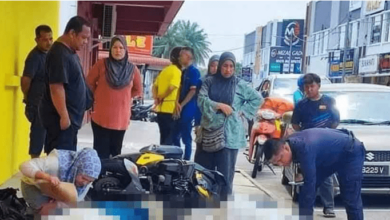Not Enough CCTV Units In Urban Areas To Fight Crime
For the police, the closed-circuit television (CCTV) camera is a useful device to nab criminals and vandals.
Just last week, the footage of a CCTV recording helped police to detect two individuals, believed to be women, allegedly involved in vandalising the murals of national leaders at Section U12 in Shah Alam. The police are now in the midst of identifying the two persons.
Earlier this month, three cats were found dead in three washing machines at a self-service laundrette in Kepong here and investigations via a CCTV recording showed a man putting the cats in the washing machines.
Considering the vital role played by video surveillance devices, are the federal capital and other urban areas in the Klang Valley adequately equipped with CCTV cameras to fight crime and other unsavoury activities?
The answer is “no”, according to crime analyst Datuk Seri Akhbar Satar who said Kuala Lumpur is far behind other cities worldwide.
Based on data obtained from the website PreciseSecurity.com, he said the United States has 15.28 CCTV cameras for every 100 individuals, China (14.36), United Kingdom (7.5), Germany (6.27), The Netherlands (5.8), Australia (four), Japan (2.72) and South Korea (1.99).
Kuala Lumpur currently has over 1,000 CCTV cameras installed in public areas, 300 of which are directly linked to the police and the rest monitored by Kuala Lumpur City Hall (DBKL).
Akhbar said these CCTV cameras are inclusive of those used for traffic monitoring and safety.
He also said that between 2012 and 2019, a total of 37,705 surveillance cameras have been installed at 3,226 private premises throughout the country.
CRIME DETERRENT
The centralised command centre at Penang City Council monitoring its surroundings via CCTV. –fotoBERNAMA (2020) ALL RIGHTS RESERVED
Besides installing more CCTV units, the cameras used must also be of higher quality and placed in strategic locations in public areas in order to facilitate investigations in the event a crime is committed, Akhbar told Bernama.
“It would be more effective if CCTV cameras located in high-risk areas are connected to a police control centre or DBKL,” he added.
In Malaysia, the camera surveillance system was first implemented by DBKL in 1966 to monitor traffic in the city centre using black and white cameras connected with direct cables and leased lines.
In the 1990s, the authorities started to install CCTV cameras in public places but the use of this “eagle eye” technology only started in earnest after 2003.
Malaysia Crime Prevention Foundation senior vice-chairman Tan Sri Lee Lam Thye acknowledged that installing CCTV cameras is an effective way to deter crime but, as he pointed out, Malaysia’s surveillance system is more oriented towards traffic monitoring than crime prevention.
“This is especially true in Kuala Lumpur,” he said, adding that DBKL should increase its allocation every year for the installation of CCTV cameras in strategic locations.
Lee said since most buildings are equipped with surveillance systems, more cameras should be installed outdoors in areas such as the back lanes, overhead bridges and open-air parking lots since crimes such as snatch theft are usually committed in those places.
In a 2007 report by Privacy International titled “Privacy and Human Rights 2006 – Country Reports”, it was stated that the incidence of snatch thefts in Kuala Lumpur plunged by 50 percent, and nationwide by 26.2 percent, after the then Housing and Local Government Ministry stepped up the use of CCTV cameras as part of its Safer Cities initiative implemented in 2004.
 MORE CCTV UNITS FOR KL
MORE CCTV UNITS FOR KL
Lee also rejected the notion that the installation of surveillance cameras in public places is an intrusion of personal privacy, saying that it only made people feel safer.
“Why should anyone be afraid of CCTV cameras when they are not doing anything that is against the law,” he asked, adding that crime would be more rampant if there were no surveillance cameras.
Kuala Lumpur mayor Datuk Nor Hisham Ahmad Dahlan, meanwhile, said out the 1,000 CCTV cameras installed in the city, 581 units were for traffic monitoring and 110 for collecting traffic data.
The remaining units are for security surveillance purposes, he said, admitting that the number was inadequate.
“We’re now in the midst of adding another 1,909 units (for both traffic monitoring and security purposes) by the end of this year,” he told Bernama.
Nor Hisham said the installation of a video surveillance system in public areas was not only a costly affair but efforts must also be made to ensure that it does not invade any person’s privacy or infringe civil liberties.
The new CCTV units to be installed by DBKL will be equipped with the zooming technology that can be used to identify vehicle number plates and even the faces of crime suspects, he added.
“We are making an effort to improve the quality of our CCTV cameras. The current technology only allows the cameras to take street view recordings,” he said.
INFORMATION
Currently, DBKL uses two types of CCTV cameras, namely Pan Tilt Zoom camera and Dome camera.
PTZ cameras can cover a wide area, which makes it easier to operate as only one unit is needed to monitor a certain location. The camera can move right and left as well as upwards and downwards, and magnify the image automatically or via a remote control.
The Dome camera, on the other hand, can point in only one direction.
Nor Hisham also said that DBKL plans to link information from the Drainage and Irrigation Department, Fire and Rescue Department and Malaysian Highway Authority to its Centralised Command Centre (CCC).
When DBKL’s CCC has access to information pertaining to floods and other emergencies, it will be channelled to road users via the electronic billboards that are part of the Integrated Transport Information System.
DBKL also plans to hold discussions with the city police chief on measures that they can undertake jointly to improve security and make Kuala Lumpur a safer city.
As of now, Sentul district police monitors 103 CCTV cameras belonging to DBKL, Brickfields police (48) and Kuala Lumpur police (16).
BERNAMA




